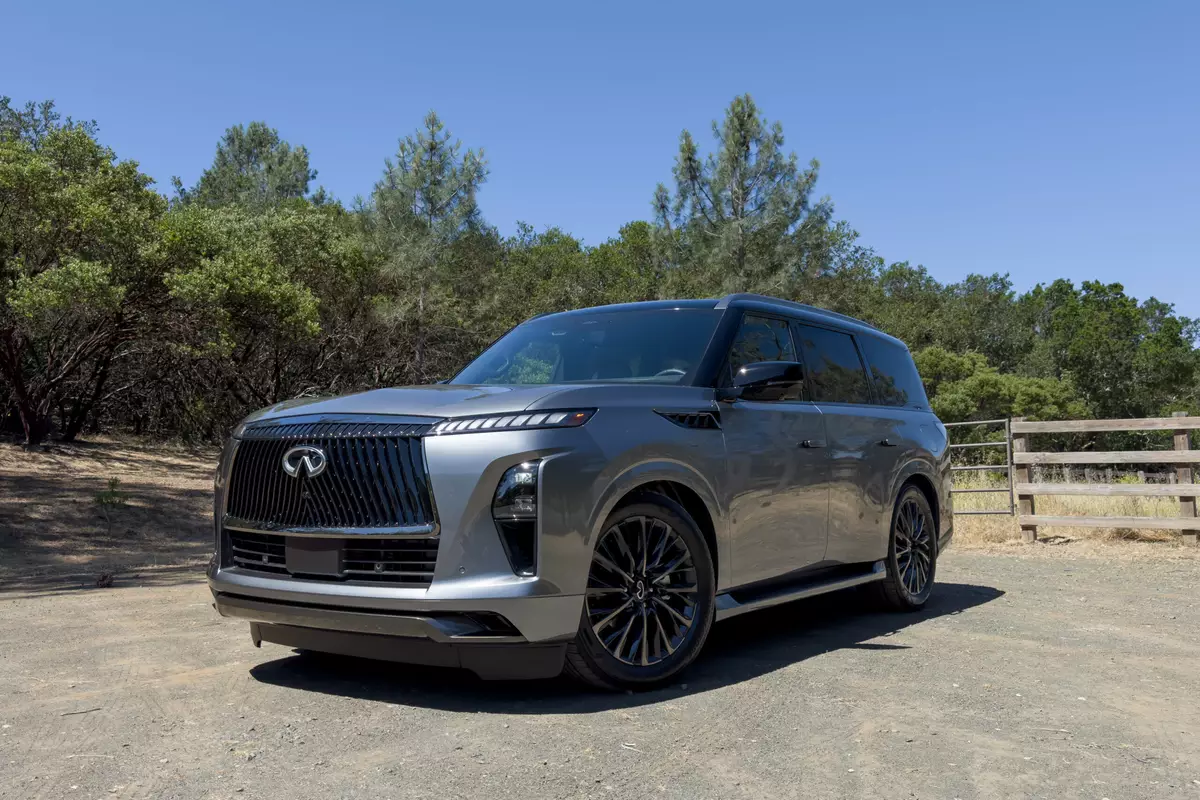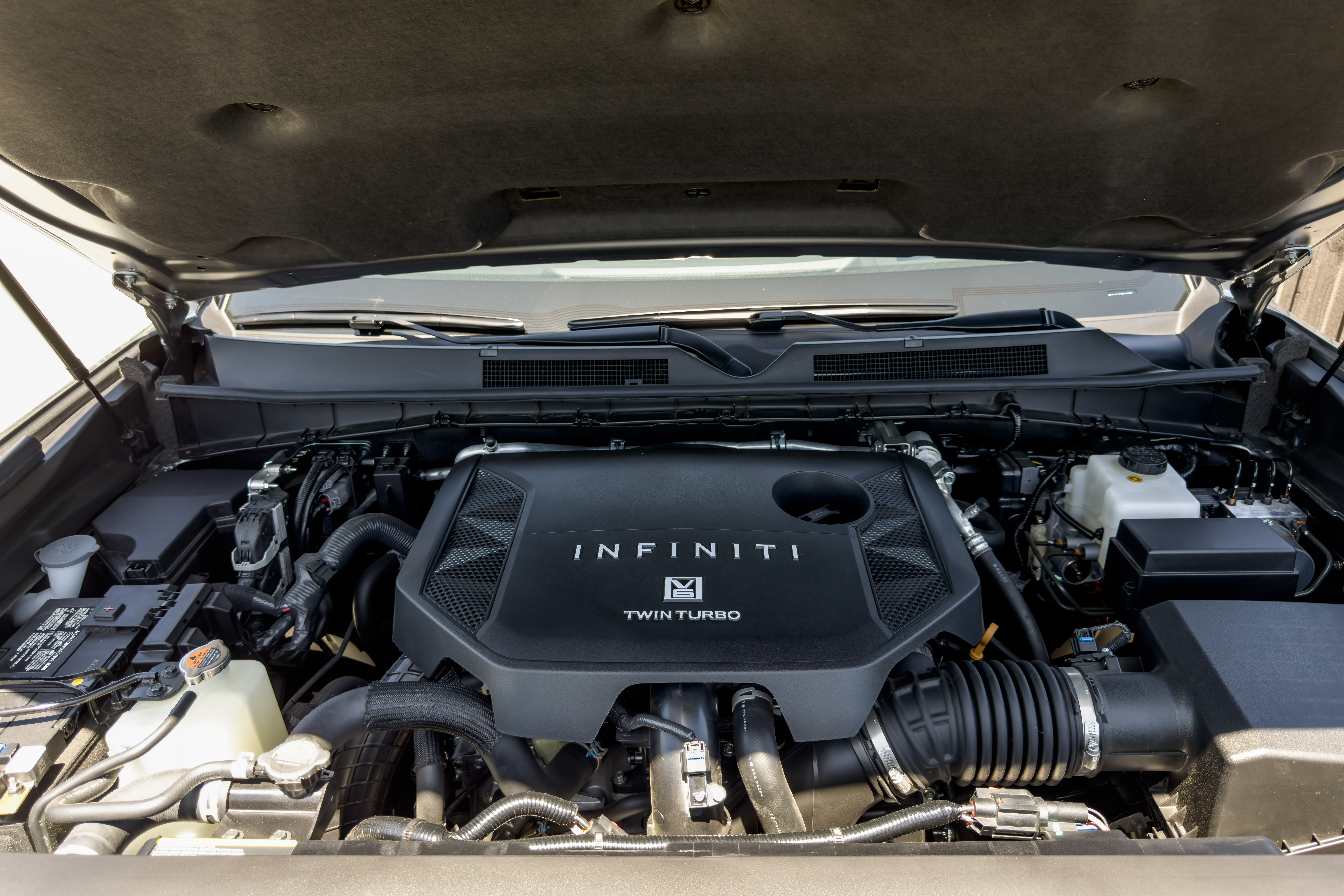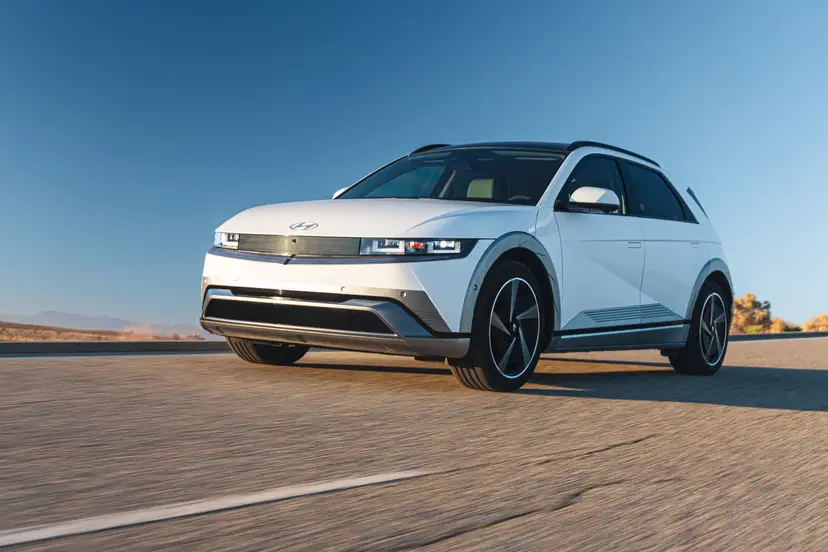
The verdict: The comprehensively redesigned and decidedly upmarket 2025 Infiniti QX80 is a moonshot away from its predecessor, and a model that Infiniti claims is the benchmark for brand offerings going forward.
Versus the competition: As we’ve only seen the top-level Autograph trim of the new QX80, we don’t know exactly how its entry-level and mid-range trims will fare. However, with a lower starting price and ceiling, the extremely well-equipped top QX80 is a fine threat to uplevel versions of the Lexus LX 600 and the like.
According to Infiniti, the 2025 QX80 is a very big bellwether for very big things to come. Yes, it’s physically ginormous, but important folks from the automaker promised that all of the good details and new brand language we like about its latest behemoth are slated to become a family affair. In essence, look to the new QX80 to get a peek at future Infiniti products that promise to inch the marque upmarket toward Lexus and the German luxury brands.
Related: 2025 Infiniti QX80 Up Close: Beautiful Behemoth
This is quite the 180 from Infiniti’s on-record “Nissan-plus” shift in brand direction back in 2020 that, at the time, signaled a potential departure from its decades-long pursuit of the established luxury segment that was sometimes right on the money and sometimes far off the mark.
We cannot generate a video preview.
Don’t Be Picky on Pricing
Aesthetically and materially, the new QX80 is a mighty effort and generally succeeds as a flagship three-row full-size SUV for this “new” Infiniti — new threads, new digs, new money. Some noise emerged over the QX80’s nearly $10,000 price jump for the new generation, decrying the value proposition versus its competitors. Oh yeah? Is that why the Lexus LX 600, inarguably its most direct competitor, starts at nearly $10,000 more for 2024 at $93,915 (all prices include destination)? The 2025 QX80 is hardly cheap at $84,445 for a base rear-wheel-drive Pure trim, but let’s take a gander at the competitive field’s cheapest, no-frills variants: $83,890 for a 2024 Cadillac Escalade, $85,260 for a Lincoln Navigator and $93,945 for a Jeep Grand Wagoneer. Seems like Infiniti has priced it right where it should be. I have not spent any time in this mythical base QX80 — no one has — but I suspect it will lag behind only the Jeep in appointments, especially considering just how luxe the top-shelf six-figure Autograph trim is.
Don’t mistake this as a declaration of the QX80 as a class leader. I merely take umbrage at the idea that because the outgoing QX80 was rightfully seen as an off-the-pace, antiquated dinosaur, the new, pricier SUV must be reaching out of its league. Nonsense; the prior QX80 was quite competitive in its day, matching many of the trucks mentioned above pound for pound, dollar for dollar.
Japanese Craftsmanship
So at least for the maxed-out $112,590 Autograph trim, it seems positioned just fine. It’s also quite the box to behold, with striking looks that move it a far step beyond the beluga bloat of the last gen. As I covered this fairly in depth at a studio preview in March, I’m not going to do another full breakdown of the new bodywork, but it raises an interesting point: Infiniti is putting effort into returning to its roots as a Japanese brand, promoting traditional craftsmanship and general stylistic motifs from its homeland. The solid bar of rear taillights, for example, are inspired by the bamboo forests outside Kyoto; the “4WD” badge on the rear and the “V6” badge on the engine cover are presented in the style of Japan’s distinctive hanko stamp; and on upper trims, you’ll find a decorative metal plate on the floormats sporting a dimpled surface reminiscent of the tsuiki style of hand-hammered Japanese metalware.
And why not? Appreciation for Japanese luxury and craftsmanship is peaking between whiskey, fine watches, apparel and collector cars, so it makes a whole lot of sense for Infiniti to capitalize on this in ways Lexus and Acura are not. Beyond the Japanese flourishes, it’s generally a rather nice place to wick away the traffic hours; the Autograph trim is absolutely decked with plush niceties like quilted leather, massage seats, real wood trim — a bit of a rarity these days — and metal accent bits scattered about the cabin.
Tech, Luxe and Everything in Between
It’s by far the most impressive part of the new SUV. Look closer and you’ll find more goodies: Those second-row thrones pack massage, heating and ventilation functions, all controlled through a dedicated center console touchscreen; third-row occupants are at least toasty thanks to heated seats, and the climate of the entire cabin should be nice and, ah, perfect thanks to an evocatively named bit of passenger-sensing tech Infiniti calls “biometric cooling.”
That’s before you even start futzing with the infotainment. Dual 14.3-inch displays take up most of the dash real estate, with the center screen handling vehicle functions, entertainment and phone projection (wireless Apple CarPlay and Android Auto) while the driver enjoys a wide display in front of the steering wheel for all of the things they would ever need to know about the drive, what’s streaming, where to turn and how much fuel they’ve burned.
Climate controls, seat functions and drive modes are handled by a 9-inch touchscreen on the front center console. I’d like more hard buttons for climate and media functions, but the console screen is reasonably reactive, haptic and simple to navigate. And if that wasn’t enough data beamed into your eyes, all but the base trim have a head-up display.
Two techy elements really stood out. First, the 24-speaker Klipsch sound system is a sight and sound to behold, with visually fascinating surround speakers around the front head restraints. These have the ability to isolate sound to the point where you can blast your tunes while folks snooze in back or carry calls over Bluetooth without turning the volume down. Of course, regular audio functions are impressive and very high-fidelity, though I didn’t spend as much time nor cycle enough of my personal reference tracks to get the full aural picture.
Secondly, the QX80’s suite of surround cameras is somethin’ else. You can artificially zoom out to every angle of the massive SUV to see what trees, parking meters and vintage Fiats you’ve run over. I’m particularly partial to the Invisible Hood View and Front Wide View that gives you a clearer view forward and lets you see past parked cars, respectively.
It’s Huge! It’s Powerful!
Top marks for occupant comfort and entertainment — and stowage, of course, with an 18% boost in cargo capacity behind the second row and a 30% increase behind the third, according to Infiniti. Comfort and utility is the QX80’s raison d’etre, but believe it or not, I did get a chance to drive the darn thing out on the open road.
And guess what: It’s totally what you would expect. It’s big, it’s torquey, it’s (mostly) comfy, and it gives you a commanding view of everything ahead for a good mile. Gone is the beloved (but terribly thirsty) naturally aspirated 5.6-liter V-8, now supplanted by a twin-turbocharged 3.5-liter V-6 that boosts power and torque to 450 horsepower and a butter-thick 516 pounds-feet of torque. You can nab RWD or all-wheel drive for the two lowest trims, but all others have AWD standard.
What’s standard no matter what trim you get is a nine-speed automatic transmission that’s related to Mercedes-Benz’s 9G-Tronic transmission. I like it in Mercs and I like it in the QX80; it’s smooth and entirely anonymous in relaxed driving, and it’s more than quick enough when you need it to kick down for passing or merging.
More From Cars.com:
- 2025 Infiniti QX80: Premium Styling, Premium Pricing
- Infiniti QX Monograph Concept Previews Imminent QX80 Redesign
- Which 3-Row SUVs Offer Captain’s Chairs?
- These 10 SUVs Have the Highest Towing Capacity
- Shop for a New Infiniti QX80
Surprising Stiffness
The suspension, despite being an advanced adaptive air suspension, was stiffer than I expected, channeling more jostle and judder into the seat than I would have preferred in something so large and couchlike. It’s still what I would consider comfortable and composed, there’s just a bit less compliance than I’d pick. Most trim levels including the Autograph have 22-inch wheels and lower-profile tires, a combination that typically doesn’t benefit ride comfort, but the base trim gets 20-inch wheels and taller-sidewall tires.
Also interesting is the lack of a “comfort” mode for the suspension, with the QX80 offering only Standard, Eco, Sport, Snow, Tow and Personal modes. Infiniti confirms that each has its own suspension profile, but I do believe a softer comfort mode should be a natural inclusion. Don’t think that’s what Personal is for — you can only choose between Standard and Sport for the custom suspension and powertrain settings.
The new turbo six-cylinder is as reassuringly meaty as they come, with some nice, robust growl when you explore the throttle. An industry colleague brought some GPS-based testing gear to the Infiniti event where I drove the QX80 and noted a 0-60 mph sprint in the mid-six-second range, which is beyond what you need to crush an on-ramp or haul a full house of family and friends up a mountain.
Everything was fine and dandy, with perfectly smooth and anodyne steering, braking that’s strong and confident for something that weighs … well, it’s still to be announced, but it’s safe to assume it weighs a lot. It doesn’t drive smaller than it is, but it’s certainly not the school bus you might expect, and I reckon if you’re the target audience for something this size, you’re likely not looking for it to shrink around you like a QX50.
It’s a good full-size luxury SUV, and a positive sign that Infiniti might be on the up-and-up toward higher territory. Despite the extra cash required, I think SUV-hungry customers will snap these up as quick as they can build ‘em. Now, the quilted-leather ball is in Nissan’s court for a new, QX80-based Armada — perhaps something in the vein of “Infiniti-minus”?
Cars.com’s Editorial department is your source for automotive news and reviews. In line with Cars.com’s long-standing ethics policy, editors and reviewers don’t accept gifts or free trips from automakers. The Editorial department is independent of Cars.com’s advertising, sales and sponsored content departments.






















 Latch
Latch
 Infant
Infant
 Rear-facing Convertible
Rear-facing Convertible
 Front-facing Convertible
Front-facing Convertible
 Booster
Booster
 Third row access
Third row access





